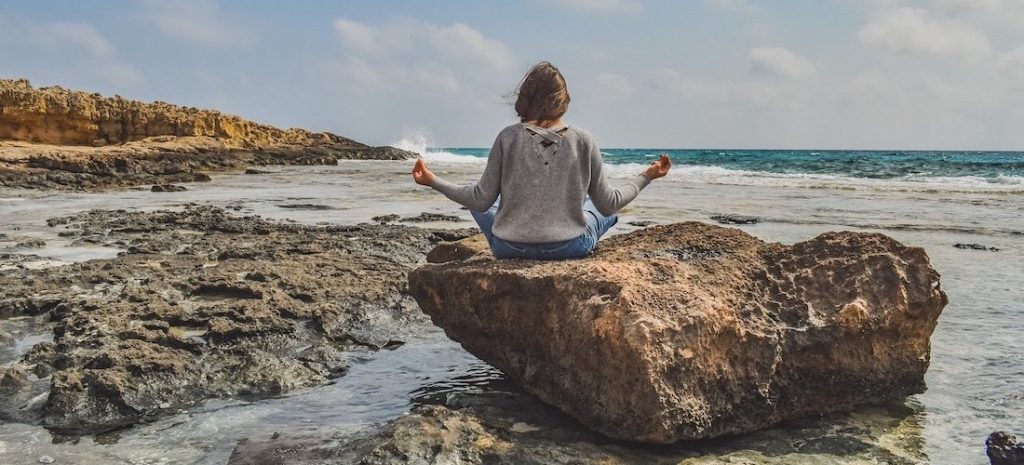One of the benefits of a regular yoga practice is that it encourages you to be more mindful, both on and off the yoga mat. This can help you deal with stress or anxiety, or learn how to savor the special moments in your life.
While you can develop some mindfulness during yoga even if you aren’t trying, you will make even more progress if mindfulness is an intentional part of your practice.
There are many ways to combine mindfulness and yoga. It’s important to find something that works for you. Here are a few simple mindfulness exercises to get you started.
Mindful Breathing: Notice the Breath
We breathe all day long, but we usually only notice the breath when it shifts — like when our lungs are congested from a cold or after running up a hill.
But the breath is a powerful tool that we can use to anchor the mind in the present moment. One reason for this is that the breath is always there, so no matter where we go, we can use it to be more mindful.
Even during yoga class. Or especially during yoga class.
Mindfulness exercises like this can be done throughout a yoga class, but if you are new to mindfulness, it’s easier to start when you aren’t moving.
- Lie down in savasana. Bring your legs about hip width apart, with your arms resting by your side, your palms turned upwards. You can also place a pillow or folded blanket under your head.
- Let your attention rest on your breath. Don’t try to change the speed of your breathing. Just watch the breath flowing in and out, noticing the rise and fall of your chest and abdomen.
- Keep coming back. Usually what happens is while you are noticing your breath, thoughts will bubble up in your mind. Sometimes you realize right away. Other times, it can take a few moments before you know that you’ve drifted away. Once you do, let the thoughts go and bring your attention back to your breath.
Mindfulness is more about bringing your attention back to the object of focus — your breath, bodily sensations, external object, or visualization —- than trying to force your attention to remain locked in one direction.
Once you find it easy to notice the breath while in savasana, try keeping your attention on your breath while you move through a yoga sequence.
You will probably find that your mind drifts away from the breath after a few movements. Don’t worry. That is normal.
Keep bringing your attention back. This is mindfulness.
Mindful Movement: Flow Within a Yoga Pose
You can bring your attention to rest on anything, including the movement of your own body.
If you practice yoga regularly, you will probably find it easy to move through a complicated yoga sequence, either on your own or when guided by a yoga teacher. If this sounds like you, you can try keeping your attention on your movement throughout your practice, noticing how your muscles and joints feel, how your body touches the mat, and even how the sweat drips down your forehead.
However, I find that mindfulness exercises are easier, especially in the beginning, if you don’t have to think as much about what you are doing. This is why I include a lot of dynamic yoga poses in my mindfulness yoga classes — it’s easy for people to pick up the movement, then they can focus on … focusing.
Here are a few simple dynamic (moving) poses that you can try. Again, keep your attention resting on the movement of your body. If your attention drifts away, just bring it back gently. You can do these poses separately.
Cat/Cow Pose
- Come onto hands and knees, with your hands underneath your shoulders and your knees underneath your hips.
- As you inhale, drop your belly toward the floor and lift your chest slightly, gazing forward.
- As you exhale, round your back up to the sky and tuck your tailbone down. Your head will hang down.
- Repeat five to ten times, with a slow, smooth breath.
Mountain Pose
- Stand with feet about hip width apart, with your arms by your side.
- As you inhale, bring your arms out to the side and overhead. You can bring the palms all the way together over your head, or keep your arms wider with your elbows slightly bent.
- As you exhale, lower your arms to your side.
- Repeat five to ten times, with a slow, smooth breath.
Bridge Pose
- Lie down on your back with your knees bent and the soles of your feet on the floor. Feet should be about hip width apart. Your arms are on the floor alongside your body.
- As you inhale, lift your hips up toward the sky, keeping your knees hip width apart. You can also bring your arms up toward the sky and to the floor over your head at the same time.
- As you exhale, lower your hips (and arms, if you lifted them) to the floor.
- Repeat five to ten times, with a slow, smooth breath.
Mindful Stillness: Maintain a Yoga Pose
Another mindfulness exercise is to keep your attention on your body during a static yoga pose, one that you hold for several breaths. This is more subtle than working with dynamic poses.
As you hold the pose, notice the sensations in your body — the tension in muscles that are active, the looseness of muscles that are relaxed, the slight movements of the joints, the shifting of your body as it maintains the pose, and even the contact of your body with the floor or mat.
This can be done with any stationary yoga pose. Standing poses like Mountain and Warrior II are easier to maintain for longer, so they are a nice way to really settle into being mindful.
But you can also practice being mindful in more challenging poses like Extended Side Angle, Crow Pose, or Handstand. In the last two, your contact with the floor is your hands, so notice how the muscles of the hand, wrist and arms contract and relax to maintain the pose.
As you hold the pose, notice when your attention shifts away from your body. When that happens, how does your form in the pose change?
In balancing poses like Handstand and Crow, does being mindful make it easier to maintain the pose?
In standing poses like Warrior II or Goddess, does keeping your attention on your body help you breathe smoothly even when your muscles start to shake?
Mindful Visualization: Keep Your Attention on an Object
In my mindfulness yoga classes, I always end with some kind of meditation. Often this involves visualizing an object, such as the moon, flowing water, a flower opening, a sunrise, or a candle.
The goal of these kinds of mindfulness exercises is to keep your attention resting on an object. When your mind drifts elsewhere, bring your attention back to the object.
Visualization is not easy for everyone. It took me a while before I could do it easily. And I find that some objects are easier to visualize than others. If you have a hard time visualizing, you can always use a real object.
Here is one of the visualizations that I use in my yoga classes,
- Sit comfortably. This can be on the floor, a bolster, or in a chair. You want your spine to be upright, with the least amount of effort.
- Close your eyes. Call to mind a sunrise. Visualize the sun just beginning to peak over the horizon.
- Bring your palms to your heart. As you inhale, bring your arms wide and visualize the sun rising a little bit more above the horizon.
- As your exhale, bring your hands back to your heart, drawing some of the light from the sun into your heart.
- Pause after your exhale and feel the light from the sun filling your heart.
- Repeat the movement and visualization five to ten times.
- When you are done, let go of the visualization. Sit quietly for a few moments, staying with the sensations in your mind and body.






